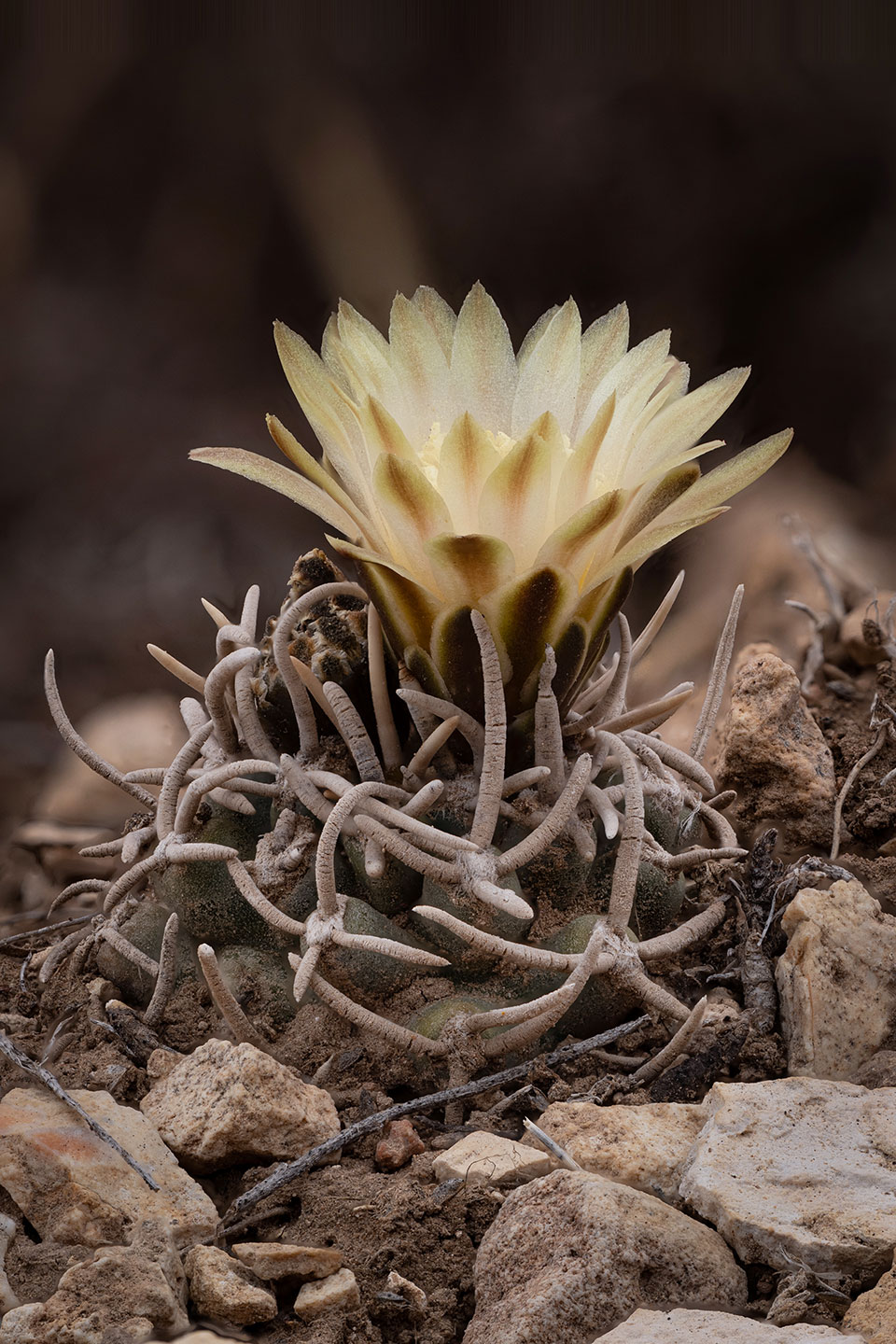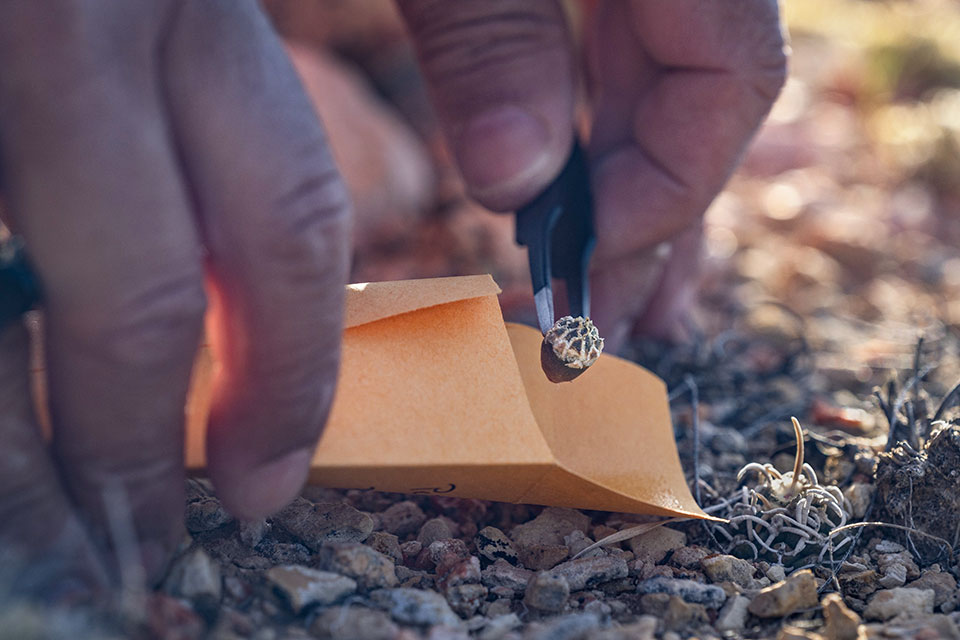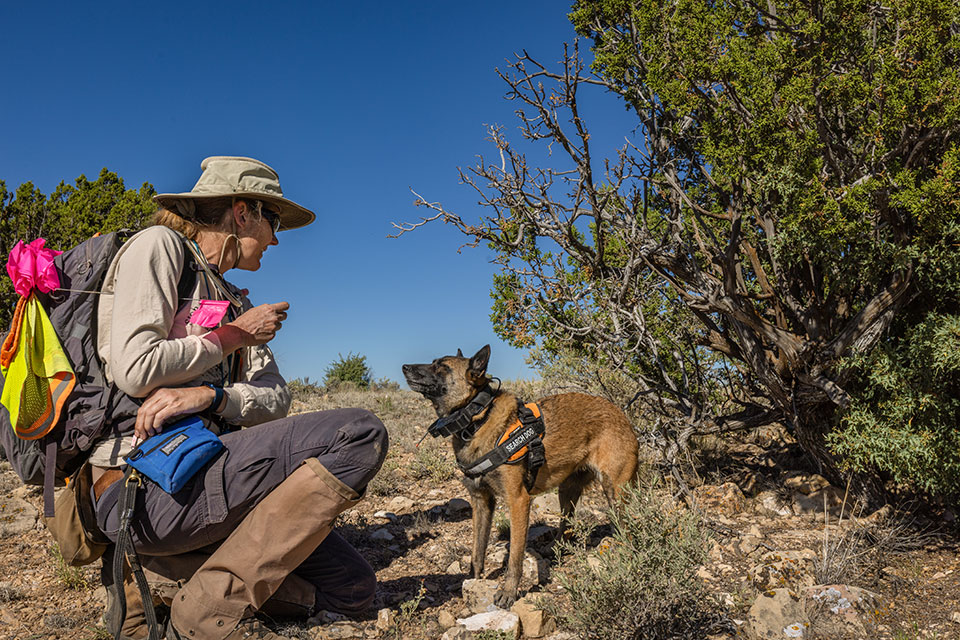When all you have is a hammer, Abraham Maslow once noted, everything looks like a nail. Similarly, when all you have are a bunch of botanists, everything looks like a pediocactus.
That version might not be as universal as the original, but it’s particularly apt on an unseasonably hot morning in late May, as staffers from Phoenix’s Desert Botanical Garden comb a high-desert landscape south of the Grand Canyon in search of a plant that grows only in this part of Northern Arizona: the Fickeisen plains cactus (Pediocactus peeblesianus ssp. fickeiseniae). The botanists are hoping to get a better idea of how many of these endangered cactuses, familiarly known as “Ficks,” actually exist. They also want to collect seeds from as many as possible, which will allow the DBG to grow new cactuses in its lab and eventually augment the species’ numbers in the wild.
But first, they have to find them, and the Ficks don’t make it easy. They’re tiny — about the diameter of a quarter, and protruding an inch or two from the ground. They’re sparsely distributed, even here in their natural habitat. And unless they’re in bloom, they blend in with other cactuses, rocks, grass and everything else on the desert floor. Human sight is good for a lot of things, but here, it’s woefully inadequate.
That’s where Circe, an energetic and talkative black Labrador retriever, and Muon, a smallish Belgian Malinois, come in. In 2022, the DBG began working with a California-based company that trains scent detection dogs for use in wildlife management and other projects. This is the dogs’ second project assisting the DBG, and the partnership is believed to be the first time dogs have been used in Arizona to find and catalog endangered plants. Steve Blackwell, the DBG’s conservation collections manager, says the dogs provide a lot of value, and not just by virtue of their sensitive snouts.
“It’s not only what they do in the field; it’s what they can do to get people to understand the plight of these plants,” he says. “A lot of times, people are more zoocentric — they care more about animals. If I can hook them with the dogs, that’s a great way to get them into plant conservation.”

a challenge. | Eirini Pajak
If the Fickeisen plains cactus hadn’t been discovered in the 1960s, we might still be unaware of its existence. Getting to its habitat south of the Canyon requires a 45-minute drive from the nearest sizable city, then another hour on dusty dirt roads and through cattle pastures. That description is vague by design: Endangered cactuses such as Ficks are prime targets for poachers. Thus, much like Henry Hill at the end of Goodfellas, these cactuses are in an undisclosed location for their own protection.
The discovery of the species happened in a different part of Northern Arizona, and the site south of the Canyon wasn’t known as a habitat for Ficks until 2006, when Greg Goodwin, a retired U.S. Forest Service researcher, went there for a general plant survey and stumbled on the cactuses. Ultimately, he spent several years surveying for Ficks in the area.
Along with the cactuses’ size and color making them hard to find, Goodwin says, the species is adept at taking cover when conditions aren’t ideal for survival. “As the habitat dries out, they tend to withdraw into the soil,” he says. “You might have seen a number of plants there in May, and you go back in November and you can’t find a single one.” The large amount of territory to survey poses an additional challenge, he says.
A tool that could help was out there; it just hadn’t been used yet. That changed in 2015, a few years after Goodwin had finished his surveys. Julie Crawford, a plant ecologist for the U.S. Fish and Wildlife Service in Arizona, began exploring the use of scent dogs to find a different species of endangered cactus. The agency worked with the Arizona-Sonora Desert Museum, near Tucson, to provide specimens to train the dogs, and the results were promising, but funding to continue the work in the field never materialized.
By 2020, Crawford was interested in trying again, this time with a different plant: the Canelo Hills ladies’-tresses orchid (Spiranthes delitescens), a critically endangered species found in cienega habitats in Southern Arizona. She contacted Lauralea Oliver, a dog trainer who had worked on the initial cactus project and later started her own detection company, k9inSCENTive.
For Oliver, working with dogs is a lifelong passion that has included work with aggressive animals and in sport detection. “I had no interest in going into narcotics and explosives [detection]; I wasn’t drawn to that,” she recalls. Search and rescue wasn’t a fit, either. But conservation work with dogs, an emerging field in recent decades, felt right. “I wanted to combine my love of dog work with something I’m passionate about, which is nature and wildlife,” she says.
Oliver’s work has included training dogs to find birds, salamanders and kit foxes. Tiny cactuses and elusive orchids were a new challenge, but the basic training process is the same. A plant sample, of either the specific species or one in the same genus, is placed in a container with a lid that hides the plant from view but allows odor to escape. At first, the dogs must identify that container when it’s placed among empty ones.

Later, plants from a different genus are added to the empty containers, and the dogs must choose the correct one. Oliver and her associate trainer, Heather Long, then run double-blind trials in which not even the trainer knows where the correct cactus is. The entire process typically takes about three months of three hourlong sessions per week, Oliver says. “It’s very Pavlovian — just building a connection,” she says. “These girls understand the game to where we can just jump right into it.”
But jumping from successful training to successful fieldwork isn’t a guarantee, Oliver adds. “I’ve been astonished in training — these tiny little cactuses, the dogs are making detections 8 to 12 meters away,” she says a couple of weeks before taking the dogs to Arizona. “It blows my mind. But there’s always some nail-biting — it’s just such a big leap, because everything that exists [in the field] has an odor.”
To fund the orchid project, Oliver and Blackwell, of the DBG, teamed up to secure a Fish and Wildlife Service grant. In 2022 and 2023, Oliver’s dogs and the DBG team conducted fieldwork in Southern Arizona, and in Crawford’s estimation, the experiment paid off. “The dogs were able to locate plants that went undetected by human surveyors,” she recalls, and they also pointed researchers to seemingly unoccupied areas, which could indicate that the orchids are still alive underground in those places.
Blackwell says he was happy with the results of that project but also wondered if a different species might be a better fit for detection by the dogs. In late 2022, he and Oliver submitted another grant proposal to the Fish and Wildlife Service, this one for finding pediocactus species in the Grand Canyon region. With funding secured, Oliver began training Circe and Muon, the two dogs she’s using for this project. Both are rescue dogs, and when it comes to scent detection, Oliver says, the breed isn’t that important. “It’s really about personality and natural ability,” she says — and after a lifetime of working with dogs, she knows a scent dog prospect when she sees one.
Ahead of the May trip, Goodwin and Crawford have made three trips to the Ficks’ habitat to identify a place for the dogs to search. The site they’ve chosen is easy enough to access, has areas that haven’t been heavily surveyed and has cactuses growing in it. All that’s left to do is find them.
“If [the dogs] can find plants that have not been previously documented,” that would make the trip a success, Blackwell says before departing. “They can cover five times the amount of ground we can cover in the same amount of time, so we’re hoping they can expand the territory where we know [the cactuses] are growing.”
But Blackwell, like Oliver, admits to a few jitters. “It is a little nerve-wracking,” he says. “You’re just hoping: Please work. Please work.”
Mother Nature offers a new worry before the weeklong trip. Originally, the DBG crew planned to spend part of the week on the Arizona Strip, looking for two other pediocactus species in the Marble Canyon area. But with expected daily highs there in the 100s, it’ll be too hot for the dogs, so Blackwell and his team are spending the entire trip south of the Canyon.
It’s hot here, too. And when the dogs get too hot, their olfactory system doesn’t work as effectively, making it harder for them to pick up scents. Typically, Oliver and Long set a cutoff temperature of 80 degrees, which on this day means getting up at 4 a.m. and being at the site by 6 to maximize fieldwork time.

While DBG botanists Wendy Hodgson and Andrew Salywon tackle a different area, Blackwell, colleague Luis Romero and the dogs and trainers focus on one of the plots the team has identified for surveying, based on the terrain and substrate where the cactuses are most likely to grow. It’s an area the botanists surveyed the day before, and the hope is that the dogs will be able to identify the Ficks the researchers missed.
As Blackwell leads the group up and down a rocky hillside, Oliver and Long use hand signals and verbal commands — “Keep going. Keep working” — to direct Circe and Muon, who are fitted with GPS trackers. “She’s in odor,” Long says, noting that Circe is on the trail of something but hasn’t quite found it yet. “You can usually tell by her tail,” she adds; it spins like a helicopter, which is where Circe gets the nickname “Circle.” When the dogs have found something, Oliver or Long announces, “She’s alerting” — and then it’s up to the team to peer at a patch of soil to see what, if anything, drew the four-legged detectives’ attention.
Initially, the dogs and the humans play to a draw. Circe and Muon find a few new Ficks but also alert on several cactus patches that had been marked with pink flags the day before, while the botanists and photographer Eirini Pajak spot some on their own. A GPS app is used to mark each plant’s location.
Some of the new finds have multiple fruits attached; from these, Blackwell carefully removes a fruit and places it in an envelope. Each fruit has 10 to 20 seeds that can be germinated at the DBG’s lab — an exercise in patience, given that the tiny cactuses found here have been growing for 10 years or longer. But the reward is a crop of Ficks that could be planted to replace those lost to poaching, cattle trampling and other factors.
By 9 a.m., the sun is getting high in the sky and the team is getting frustrated. That includes Circe, who’s been over a 200-square-foot area for several minutes but can’t pinpoint the source of what she’s smelling. She and Muon take a shade and water break while the botanists and trainers discuss waking up even earlier the next day to arrive at the site before sunrise. With the temperature approaching 80, the dogs are nearing the end of their workday.
Suddenly, Circe leaves the group and alerts on a rocky patch of desert a few hundred feet away. The botanists follow her and crouch nearby, and there they are: a half-dozen or so Fickeisen plains cactuses, all with multiple fruits and undiscovered until now.
In the next couple of days, aided by earlier starts and growing familiarity with the species, the dogs and botanists will find many more of these cactuses and increase their understanding of the species’ range. In the process, the DBG team and the trainers will learn lessons they can apply to their next surveying trip, planned for Marble Canyon this fall. But for now, after three hours of searching for tiny things in an immense place — and seeing them everywhere and nowhere, all at once — finding a half-dozen Ficks feels like striking oil.
“Good job, Circe!” Oliver cheers as the team celebrates. “You did it!”
Circe barks, jumps and wags her tail. She’s a dog, after all.
To learn more about the Desert Botanical Garden and the work it does to conserve and protect endangered plants, visit dbg.org.

